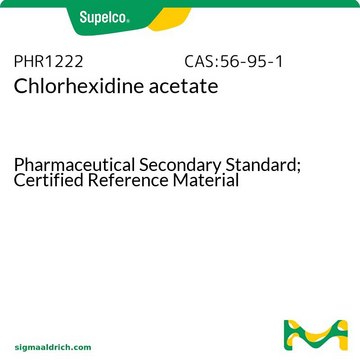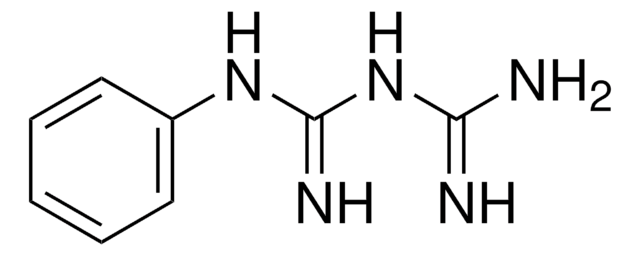Kluczowe dokumenty
C6143
Chlorhexidine diacetate salt hydrate
bis(biguanide) antimicrobial
Synonim(y):
1,6-Bis(N5-[p-chlorophenyl]-N1-biguanido)hexane; 1,1′-Hexamethylenebis(5-[p-chlorophenyl]biguanide)
About This Item
Polecane produkty
Poziom jakości
Formularz
powder
CMC
0.01% (25°C)(w/v)
rozpuszczalność
ethanol: 50 mg/mL
spektrum działania antybiotyku
Gram-negative bacteria
Gram-positive bacteria
Tryb działania
cell membrane | interferes
temp. przechowywania
room temp
ciąg SMILES
ClC1=CC=C(NC(NC(NCCCCCCNC(NC(NC2=CC=C(Cl)C=C2)=N)=N)=N)=N)C=C1.OC(C)=O.OC(C)=O
InChI
1S/C22H30Cl2N10.2C2H4O2/c23-15-5-9-17(10-6-15)31-21(27)33-19(25)29-13-3-1-2-4-14-30-20(26)34-22(28)32-18-11-7-16(24)8-12-18;2*1-2(3)4/h5-12H,1-4,13-14H2,(H5,25,27,29,31,33)(H5,26,28,30,32,34);2*1H3,(H,3,4)
Klucz InChI
WDRFFJWBUDTUCA-UHFFFAOYSA-N
Zastosowanie
Działania biochem./fizjol.
Inne uwagi
Oświadczenie o zrzeczeniu się odpowiedzialności
Hasło ostrzegawcze
Warning
Zwroty wskazujące rodzaj zagrożenia
Zwroty wskazujące środki ostrożności
Klasyfikacja zagrożeń
Acute Tox. 4 Oral - Aquatic Acute 1 - Aquatic Chronic 1 - Eye Irrit. 2 - Skin Irrit. 2 - STOT SE 2
Organy docelowe
Liver,Teeth
Kod klasy składowania
11 - Combustible Solids
Klasa zagrożenia wodnego (WGK)
WGK 3
Temperatura zapłonu (°F)
Not applicable
Temperatura zapłonu (°C)
Not applicable
Środki ochrony indywidualnej
Eyeshields, Gloves, type N95 (US)
Wybierz jedną z najnowszych wersji:
Masz już ten produkt?
Dokumenty związane z niedawno zakupionymi produktami zostały zamieszczone w Bibliotece dokumentów.
Klienci oglądali również te produkty
Nasz zespół naukowców ma doświadczenie we wszystkich obszarach badań, w tym w naukach przyrodniczych, materiałoznawstwie, syntezie chemicznej, chromatografii, analityce i wielu innych dziedzinach.
Skontaktuj się z zespołem ds. pomocy technicznej











